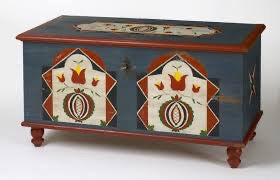
Pennsylvania Dutch Period (1720 to 1830)
Pennsylvania Dutch (1720 to 1830)
The Pennsylvania Dutch period was predominantly fueled by German influence but developed its own traits and peculiarities. The pieces were simple and utilitarian, with colorful hand-painted motifs. The furniture from this period features straight lines, simple turnings, and tapered legs made from walnut, oak, and pine.
Pennsylvania furniture makers were renowned for their hand-painted hope or dowry chests. Built to store the linen made by young women, the dowry or hope chests were customarily painted a light blue color over which was painted a variety of decorative embellishments such as vases of flowers, tulips, stars, birds, angels, and unicorns among others.
Moravian chairs were commonplace as well as ladder back chairs during this period. The Moravian made with splayed legs was built with a carved out heart through the backrest. Peg legs without rungs had the effect of simplifying the making process.
Pennsylvania Dutch furniture was made in country style without the sophistication of design seen in urban centers like Philadelphia. This furniture catered to the needs of ordinary folk in the farmhouses of the German or “Dutch” Pennsylvania community and embodied its rich personality.